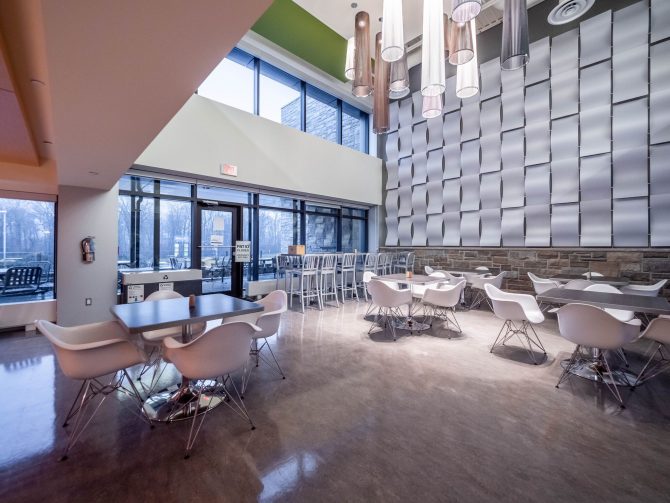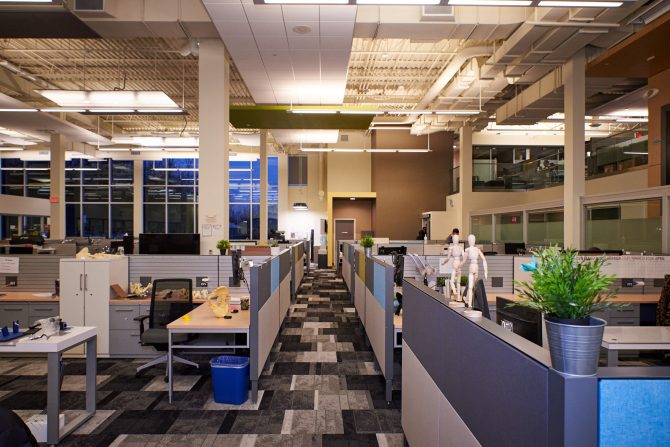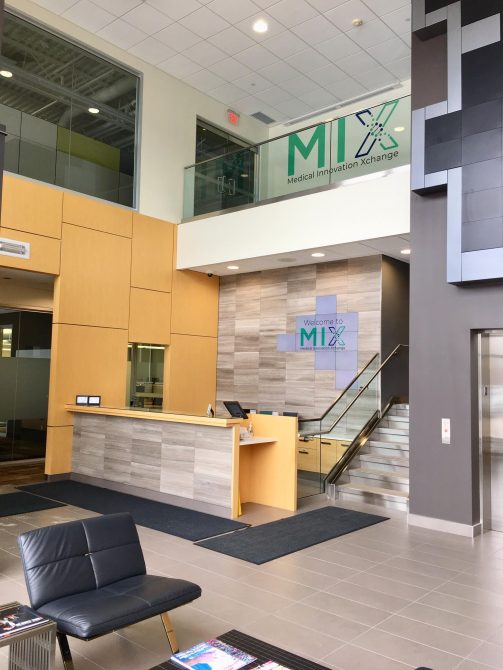
Medical Innovation Xchange scales start-up activity
Stephen Law
Electronics Engineering Medical designs Editor Pick electronic innovation medicalIndustry-led hub ensures medtech designs are in the MIX
Timing they say is everything. That certainly was the case when the doors opened to Canada’s first industry-led hub dedicated to helping medical technology start-ups scale. Unveiled amid the emergence of a global pandemic in January 2020, the Medical Innovation Xchange (MIX) in Kitchener Ontario led off with its mission of paying it forward, just as the planet was plunged into an unprecedented global medical emergency.
Leading by mentorship and by facilitating domestic connections to industry experts, MIX assists nascent designers turn prototypes into medical devices. The hub’s goal is help companies navigate specific challenges efficiently, avoid costly mistakes, and get products into hospitals faster to meet increasing demands, according to MIX executive director Elliot Fung.

Medical Innovation Xchange (MIX)
To provide a clearer view of what MIX does and how the facility operates in reducing barriers and bridging the resource gap facing medical technology start-ups, Fung provides us with the following perspectives.
Q. How big is the actual facility and how many people does it employ and in what range of capacities?
MIX currently has a footprint of just over 40,000 sqft at our facility in Kitchener. Within that space, we have five companies in residence who employ about 150 people. As companies are able to customize their spaces, we also have a number of labs and light assembly spaces as well as shared collaboration spaces like meeting rooms, a bistro, event space and reception. MIX companies have a wide range of talent on-site, including engineering, quality assurance, software development, clinical, commercialization/sales, communications, marketing and strategy.
Q. What geographic region does MIX welcome users from: I.E. K/W Region, GTA, out of province, international.
MIX is pleased to be Canada’s first ever industry-led non-profit hub for scaling medical technologies. We are 100% focused on supporting Canadian medtech companies and helping them to overcome barriers to growth, scale and commercialization. Therefore, while all of our companies are currently based in Waterloo Region, we are happy to welcome any medtech company domiciled in Canada.
Q. How does MIX determine which firms gain access to the hub’s support?
It is extremely important that companies who join the MIX community not only share the MIX values – specifically a vision to build a strong domestic medtech ecosystem and grow more Canadian medtech companies – but also be in the best position possible to achieve success. Through our selection process, we learn about a prospective company and determine if they are in the right phase of their growth, that they are in a ‘scaling’ phase, and that we have the best supports available to actually help them. Companies meet with a selection committee who ultimately make a decision to welcome them in to the hub either as a resident or as a network partner.

Q. Describe what it means to be an ‘industry-led’ hub.
There are many excellent technology hubs across the country, particularly in Southwestern Ontario, who are primarily founded or funded by either government or academic institutions. These hubs are vital to the ecosystem and are important partners to medtech companies particularly in the start-up phase. MIX is industry-led, meaning we were founded specifically by medtech company partners (industry) who share a vision and passion for supporting the ecosystem and building more successful companies.
Q. As industry experts in turning prototypes into medical devices, what are some of the most common challenges or mistakes faced by companies attempting to get their products into hospitals faster to meet increasing demands.
As MIX works with later stage companies, we see very unique challenges during the product development lifecycle. The process in which medtech companies need to follow in order to commercialize their products in to the health care system is complex and long. One of the biggest challenges is being able to bridge your financing during the regulatory process – the period in which a medical device is going through certification and prior to sales starting. The regulatory process itself can be complicated, and for a small domestic medtech company can seem overwhelming and daunting; this can lead to decisions that may negatively impact the longevity and success of the company in the long run. It is critical at the onset that companies have very clear understandings and expectations of the process in which they need to follow to commercialize a medical technology. Unfortunately, a common mistake is that a lack of understanding of systems, procurement and the decision making process can lead to reduced performance and success.
MIX and MIX companies are experts in helping to solve these challenges and in helping companies in avoiding these mistakes before they even make them. We have found that one of the most valuable resources for scaling MedTech companies is being able to learn from people and companies who have done it already; either made mistakes, overcome challenges or learned from others.
Q. Describe some of the ways MIX provides mentorship to start-ups.
MIX companies are considered ‘scaling’ – which means that they are typically in a stage where they are going through regulatory processes, pre-sales and early sales. Mentorship is tailored to each company and their needs on a point-in-time basis; we connect teams with mentors who have valuable information and advice, we create an environment and culture that promotes collaboration and sharing, and we offer a space that allows for growth while surrounded by people and companies who are like-minded.
Q. How does MIX deliver medical device engineering services? Does MIX have its own dedicated engineering team or department or is it outsourced? Is the product testing conducted on premise and to what level is MIX capable of product testing?
MIX does not deliver medical device engineering services per se. MIX mentors who have experience or who are experts in product development, engineering, testing, QA etc provide their mentorship services if and when needed. MIX does not offer the service itself, but instead the mentorship and guidance for companies to be successful on their own.

Medical Innovation Xchange (MIX)
Q. Allocating financial assistance or funding by start-ups is often the differentiator in achieving the necessary foothold in developing new tech. What role does MIX play in this area of support?
MedTech companies are particularly vulnerable in crossing the ‘Valley of Death’ while bridging the gap leading to industrial commercialization. The timelines can be longer, the risk greater and available funds need to be distributed across a greater amount of time. MIX companies benefit from mentorship from more established companies who can provide invaluable advice on fundraising and allocating investments during this critical time.
Q. How does the MIX manufacturing facility serve an electronic hardware OEM?
Are production facilities set for prototyping only? Are there production run limitations?
The MIX facility is a customized space for scaling medtech companies. We currently occupy about 40,000sqft with about half of the space being used for workstations and collaboration/common areas and about half reserved for lab, operations and assembly space. MIX residents have the ability to customize their space to meet their needs.
Q. Describe some of the challenges related to creating a medical device from that of a personal fitness device.
There are significant differences between commercializing a medical device compared to a personal fitness device. The pathway to commercialization is significantly different as a medical device goes through clinical testing and federally regulated requirements to aid in the diagnosis, cure, mitigation or treatment of a medical condition. A personal fitness device does not need to go through the same rigors, and is generally considered to be a wellness tool as opposed to a medical device.
As a result, a significant amount of clinical testing and validation is conducted on products being labelled as medical devices which supports federally governed regulatory requirements. Consequently, the time that it takes to bring a regulated medical device to market can be significantly longer; companies need to make strategic decisions and find strategic investments that can carry them through to commercialization.
The sales approach to medical devices vs. personal fitness devices is also quite different. Health technology companies commercializing a personal fitness device will be competing in a vast, unregulated consumer market, while medtech companies developing regulated devices will typically follow health system and clinical procurement models. Both have their advantages and disadvantages, it just depends on the companies’ strategy and anticipated outcomes.
Q. Detail MIX’s capabilities in respect to ISO certifications.
As an organization, MIX does not hold an ISO certification, however our mentors support resident companies in their certification processes in particular Quality Systems ISO 13485.
Q. Is there a preferred company size or success threshold whereby firms must move out of MIX to make room for other medtech start-ups?
The short answer is ‘no’. MIX anticipates that resident companies will stay with us for at least 18 months from the time that they join us to when they ‘outgrow’ the facility. However, we do not put on any timelines and welcome resident companies to grow within our space as much as and as long as possible.
Q. Is the Covid-19 pandemic playing a significant role in new product introductions at MIX?
Due to the nature of our businesses, MIX residents remained open and operational during the pandemic. Over the past 18 months, our companies have realized great successes and launched a number of new products, including one new product that is a collaboration between two of our resident companies.
Q. Describe the significance of the role played by anchor tenant Intellijoint Surgical in formation of MIX.
MIX and the entire medtech ecosystem is fortunate to have the leadership and commitment from Intellijoint Surgical. Intellijoint Surgical is considered one of MIX’s anchor companies, and is the founding organization of MIX. MIX and MIX resident companies benefit from their experience in bringing a medical device to market while staying headquartered in Waterloo Region. Intellijoint is considered a local success story, and they continue to demonstrate incredible leadership across the ecosystem for up and coming medtech startups.
Q. Who are some the other key medtech players involved with MIX.
MIX is fortunate to have a number of established Canadian-based medtech companies involved in supporting our mission. This includes some large companies like Baylis Medical, who became MIX’s newest mentor company in the summer of 2021. Other network partners who have partnered with MIX include other Canadian based companies such as Nicoya, KA Imaging, Conavi and COSM, Exact Imaging and Kenota Health.
Currently besides Intellijoint Surgical, MIX has four other resident companies, which include Emmetros, Bloom Care Solutions, NERv Technologies and Vena Medical.
MIX is also fortunate to have significant partnerships with the local ecosystem, including the incubator Velocity, the Accelerator Centre, the City of Kitchener, Communitech and academic institutions University of Waterloo and Western University.
